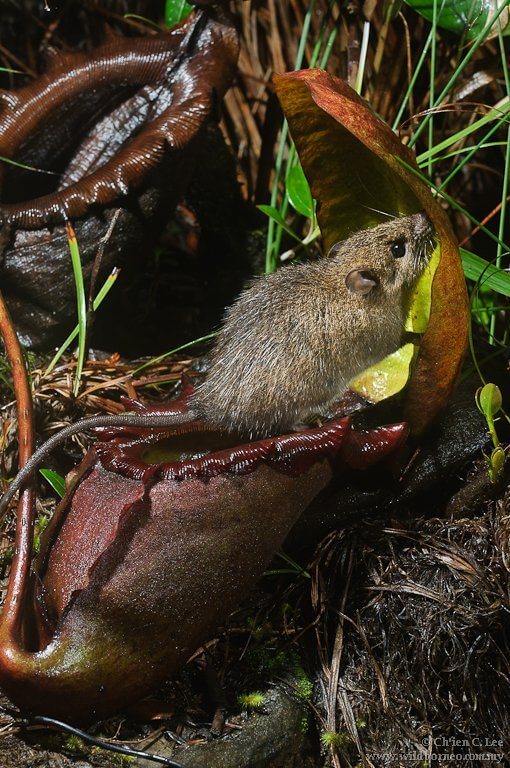Danit plants are used as chemical toilets for woodpeckers and other mammals

Noam Levithan and Yonat Ashhar Galileo Magazine
The remnants of the rainforests of Borneo, the third largest island in the world, are home to dozens of species ofNepenthes) – carnivorous plants with pitcher-like leaves. These urns are colorful containers with lids that contain bundles of digestive juices. Sweet nectar secreted from the smooth rim of the jar attracts insects, and sometimes even other animals, which slip and fall into it. The insects drown in the digestive juices into which they have fallen, are digested by the plant and thus provide it with the nitrogen and phosphorus it needs.
Since the beaks of some of the species are very large, they have the name of predators of mammals, reptiles and other vertebrates. In the mountains of Borneo, you can find several species of this kind of woodpecker, among them the largest woodpecker in the world, the royal woodpecker (n.rajah), increase only on Mount Kinabalu; The volume of the jug may exceed two liters! However, there is no evidence that even these huge jugs are used to capture large animals, and in decades of observations, only three cases were discovered in which vertebrates were trapped inside the royal jug. The three unlucky victims slipped and drowned in the pitcher by accident, and are not the favorite prey of the pitcher, which is insects and other arthropods. If so, why does the pitcher "waste" energy on building huge traps when even much smaller pitchers will be enough to catch the insects?
In the study, published in the scientific journal New phytologist, Lijin Chin and Charles Clarke from Monash University in Malaysia and Jonathan Moran from Royal Roads University in Canada present a possible answer to this question.
During their work in Borneo, the researchers noticed that many of the large pots of royal holly plants, Lowe's holly (N. lowii), and a large leaf pitcher (N. macrophylla). These dung are from hoeing trees (Tupaia montana), a small mammal which, despite its name, is not a primate at all but a relative of the primates. The woodpeckers like to lick the abundant nectar from the concave lids of the plants. During the licking, the small mammals sit over the opening of the urn, with their feet clinging to its rim, and defecate.
Cameras placed by Chin and her colleagues recorded the woodpeckers visiting the plants and showed that each visit lasted about 24 seconds on average.
The droppings that the woodpeckers drop into the pots some of the times they stop to eat provide the plants with most, if not all, of the nitrogen they need.
The researchers looked at the features that have developed in the "predatory" dung beetles, which ensure that the woodpeckers will visit them and drop dung, and sometimes urine, into their urns. They found that all the pitcher plants that benefit from the visit of the woodpeckers have large pitchers with concave lids and secrete a lot of nectar. In addition, the value of the angle of the lid towards the opening of the urn means that the distance from the opening to the float secreted on the lid is equal, on average, to the length of a stick of wood. This situation requires the woodpecker to "ride" on the jar in order to successfully lick the nectar from the lid. Other carnivorous Danes are not endowed with all these features, and indeed were not found in the contents of dung.
The findings of the study show that the three species of woodpeckers that were tested were adapted during evolution to capture the dung of tree saplings as a source of nitrogen, and their large jugs are part of this adaptation. According to the researchers, it is possible that other large holsters with appropriate characteristics, such as a recoil holster (N. ephippiata(or as Attenborough Dutch)N.attenboroughii), are also fed on rolls. They also believe that the source of the dung may be diverse; For example, it is very likely that Raffles Danes (N. rafflesiana) enjoy nitrogen that comes from the droppings of the bats sleeping during the day in their pots.
In June 2011 Clark and colleagues publish an article inPLoS ONE who showed that rats (Rattus baluensis) also defecate in the bowl of the royal pitcher. The rats used the toilets of the pitcher mainly at night and the tree branches only during the day.
The gorse plants, like other carnivorous plants, prey on animals in order to extract nutrients from them that are essential for their growth. It seems that some of the species have found additional ways to obtain food from an animal - by utilizing their dung.
The original article:
Chin, L., Moran, JA & Clarke, C . Trap geometry in three giant montane pitcher plant species from Borneo is a function of tree shrew body size. New Phytologist 186, 461-470 (2010). doi: 10.1111/j.1469-8137.2009.03166.x
The original article was published in Galileo magazine issue 141, May 2010
